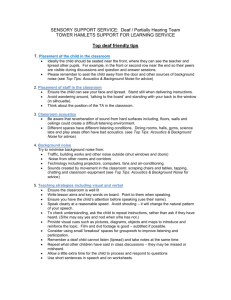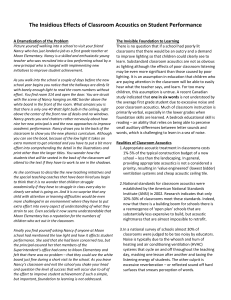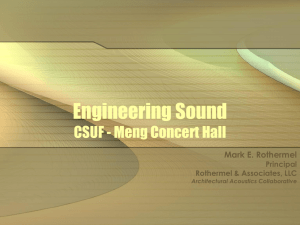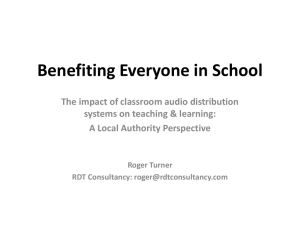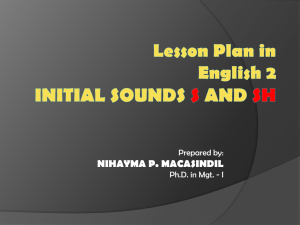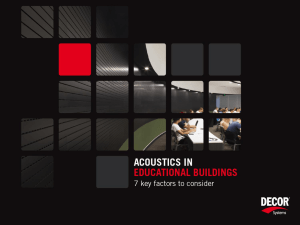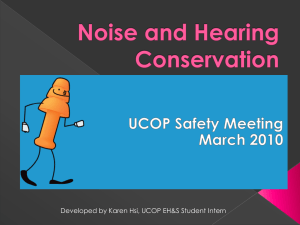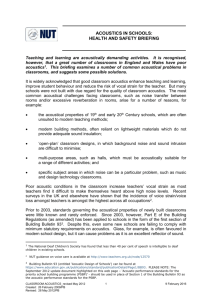Classroom Acoustics - Bradford Schools Online
advertisement
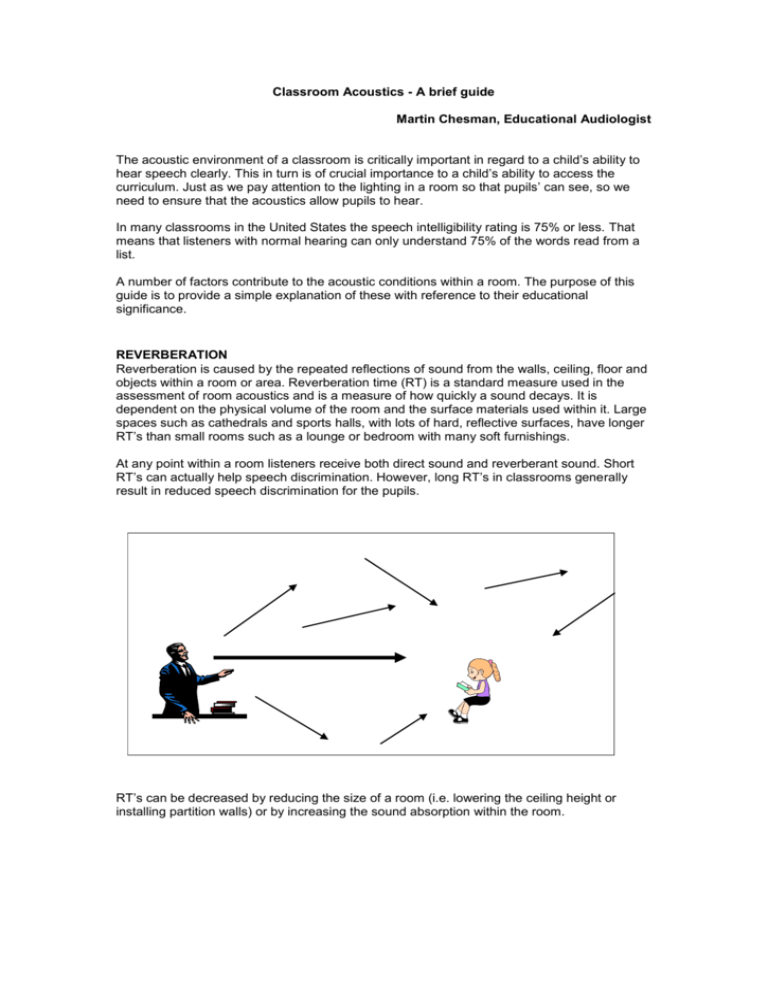
Classroom Acoustics - A brief guide Martin Chesman, Educational Audiologist The acoustic environment of a classroom is critically important in regard to a child’s ability to hear speech clearly. This in turn is of crucial importance to a child’s ability to access the curriculum. Just as we pay attention to the lighting in a room so that pupils’ can see, so we need to ensure that the acoustics allow pupils to hear. In many classrooms in the United States the speech intelligibility rating is 75% or less. That means that listeners with normal hearing can only understand 75% of the words read from a list. A number of factors contribute to the acoustic conditions within a room. The purpose of this guide is to provide a simple explanation of these with reference to their educational significance. REVERBERATION Reverberation is caused by the repeated reflections of sound from the walls, ceiling, floor and objects within a room or area. Reverberation time (RT) is a standard measure used in the assessment of room acoustics and is a measure of how quickly a sound decays. It is dependent on the physical volume of the room and the surface materials used within it. Large spaces such as cathedrals and sports halls, with lots of hard, reflective surfaces, have longer RT’s than small rooms such as a lounge or bedroom with many soft furnishings. At any point within a room listeners receive both direct sound and reverberant sound. Short RT’s can actually help speech discrimination. However, long RT’s in classrooms generally result in reduced speech discrimination for the pupils. RT’s can be decreased by reducing the size of a room (i.e. lowering the ceiling height or installing partition walls) or by increasing the sound absorption within the room. Longer reverberation times have a more detrimental effect upon hearing impaired listeners than those with normal hearing. Speech discrimination for normally hearing adults is not affected until RT’s exceed 1 second. However, hearing impaired listeners report significant perceptual difficulties once RT’s exceed 0.4secs. ABSORPTION OF SOUND As stated above, RT’s are directly affected by absorption and/or reflection of sounds. Materials differ according to how much they reflect or absorb sound. Soft materials absorb sounds better than hard (reflective) materials. Acoustic ceiling tiles absorb sound and therefore reduce reverberation. Absorptive materials at the back of a classroom help prevent sounds from being reflected back into the room and adversely affecting those pupils at the back. Carpets predominantly absorb high frequency elements of speech which actually aid speech discrimination, but they can effectively reduce the overall amount of noise created within a room. BACKGROUND NOISE This is any noise within a room that competes with what you are trying to listen to. It can be generated: from outside the building (traffic noise, aeroplanes, pupils playing sports etc.), by features within the building (heaters, ventilation systems etc.) by activity outside the classroom (busy corridors, kitchens etc.) by activity within the classroom (pupils talking, chairs scraping etc.). Any level of background noise will adversely affect access to speech. Unhelpful reverberant speech sounds will add to the level of background noise. SPEAKER-LISTENER DISTANCE All sounds are less intense as the distance from them increases. When pupils are close to the source of sound – generally the teacher – the level of direct sound is greater than the level of reverberant sound within the room. When the listener is further away, the reverberant sounds dominate. This reverberant sound generally masks speech, rendering it less audible. Speaker–listener distance Level of teacher’s voice Level of reverberant sound and background noise SIGNAL-TO-NOISE RATIO This is a simple comparison useful for estimating how understandable speech is in a room. The signal is what the listener is attending to. This will generally be the teacher’s voice, but may be another pupil, a television programme etc. Noise is any sound that is present and is competing with the signal. If the sound level of a signal is 70 decibels (dB) and the noise is 60dB, the signal to noise ratio (S/N) is +10dB. If the signal is 65dB and the noise is also 65dB, the S/N is 0. A negative S/N is also possible. The S/N will vary throughout the room as the signal and noise levels vary. The S/N generally will be lowest - therefore worse - at the back of the classroom where the level of the teacher’s voice has fallen to its minimal value or near a source of noise where the noise level is at its maximum. PUPILS AFFECTED BY POOR ACOUSTICS Research has demonstrated that certain groups are more adversely affected by poor room acoustics than others. These include: younger children who are still developing language children with a hearing impairment children for whom English is an additional language children with learning and/or attention difficulties children with auditory processing problems Adults who have hearing within normal limits can cope with a signal-noise ratio (S/N) of 0dB. Young children benefit from S/N of +10dB. Children with a hearing impairment need a S/N of at least +15dB. The British Association of Teachers of the Deaf (BATOD) recommend S/N exceeding 20dB across the frequency range 125Hz-750Hz, and 15dB across the range 750Hz-4000Hz. EFFECTS UPON TEACHING STAFF Crandell & Smaldino cite research showing the various effects of high levels of background noise upon teachers. It is well correlated with teacher fatigue, increased tension and discomfort, an interference with teaching and speech recognition, and a significantly higher incidence of vocal problems than is found in the general population. WHAT CAN BE DONE TO HELP Put rubber tips chair legs. Fit carpets, curtains and other soft furnishings where appropriate. Fit acoustic ceiling tiles. Fit pin boards at the back of classrooms. Locate noisy activities away from main teaching areas. Ensure quiet in corridors. Install soundfield systems. BUILDINGS BULLETIN 93 The exemption of LEA maintained schools from building regulations has now ended. Buildings Bulletin 93 Acoustic Design of Schools lays down the acoustic specifications for all new builds. Section 1 of BB93 – performance standards for new buildings - came into force on 1st July 2003. Whilst this legislation is not retrospective, the British Association of Teachers of the Deaf write that “it is likely that it will be used as a ‘best practice’ document for existing premises”. (see references) If you have any queries please contact me. Support Team for Deaf Children Future House, Bolling Road, Bradford BD4 7EB (01274) 385833 martin.chesman@educationbradford.com Some references and further reading: 1. Classroom Acoustics Booklet. Pub by The Acoustical Society of America www.nonoise.org/quietnet/qc/booklet.htm 2. Classroom Acoustics for Children with Normal Hearing and with Hearing Impairment. Carl C Crandell & Joseph J Smaldino. Language, Speech and Hearing Services in Schools, Vol. 31, p362-370 October 2000. 3. Room Acoustics and Speech Perception. Arthur Boothroyd www.arthurboothroyd.com 4. Sound Treatment for Classrooms. The British Association of Teachers of the Deaf. www.batod.org.uk/sound-treatment_nf.htm 5. Classroom Acoustics Resource List www.edfacilities.org/rl/acoustics.cfm 6. Building Bulletin 93 Acoustic Design of Schools www.teachernet.gov.uk/acoustics
